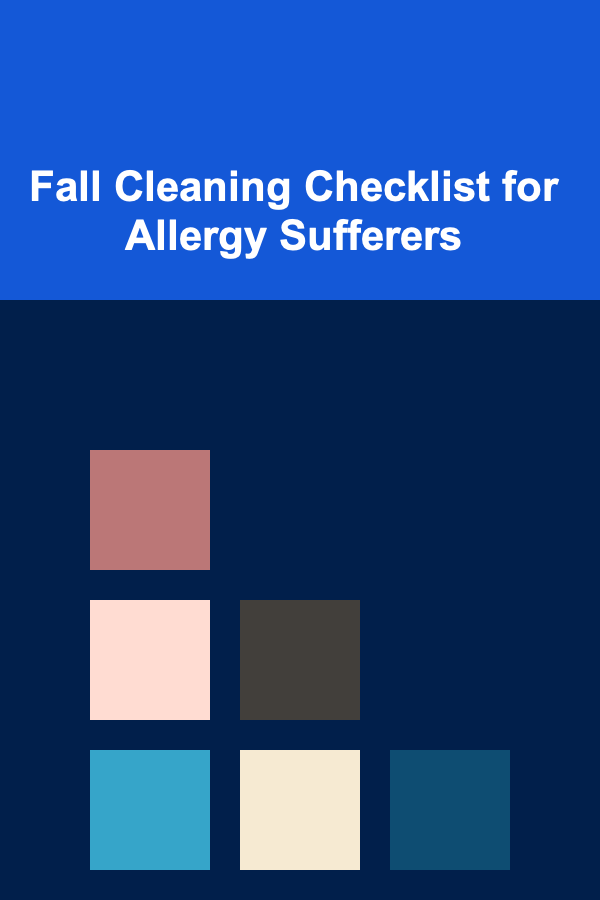
Fall Cleaning Checklist for Allergy Sufferers
ebook include PDF & Audio bundle (Micro Guide)
$12.99$5.99
Limited Time Offer! Order within the next:

As the leaves begin to change and the air turns crisp, fall is a time of renewal and change. For many people, it's a season that brings both beauty and relief after the heat of summer. However, for allergy sufferers, fall can also be a challenging time. With the start of the cooler weather, seasonal allergens such as mold, dust, and pollen begin to circulate in the air, exacerbating allergy symptoms.
One of the best ways to reduce the impact of fall allergens is through a thorough fall cleaning. An effective cleaning routine can help remove common allergens from your home and create a healthier living environment. Whether you're dealing with dust mites, pet dander, or mold spores, this comprehensive fall cleaning checklist will guide you through essential tasks to minimize allergens and make your home more comfortable during the fall months.
Start with the Air: Clean HVAC Systems and Change Filters
Your home's heating, ventilation, and air conditioning (HVAC) system is a central part of your indoor air quality. As temperatures drop and you begin using your heating system, it's crucial to ensure that it's not circulating dust and allergens throughout your home.
Steps:
- Change Air Filters: HVAC filters can accumulate a significant amount of dust, pollen, pet dander, and other allergens. Change the filters in your HVAC system according to the manufacturer's recommendations, usually every 1-3 months.
- Clean Vents and Ducts: Dust and debris can collect in air ducts and vents over time. Use a vacuum with a hose attachment to clean visible vents. For more thorough cleaning, consider hiring a professional duct cleaning service.
- Consider an Air Purifier: If you suffer from severe allergies, adding an air purifier to your HVAC system or individual rooms can help. HEPA (high-efficiency particulate air) filters are particularly effective at trapping fine particles like dust and pollen.
By taking these steps, you'll ensure that the air circulating in your home is cleaner and free from harmful allergens.
Deep Clean Carpets and Rugs
Carpets and rugs are notorious for trapping allergens such as dust mites, mold spores, pet dander, and pollen. As you prepare for fall, it's a good time to give your carpets and rugs a deep clean.
Steps:
- Vacuum Thoroughly: Use a vacuum cleaner with a HEPA filter to capture dust, dirt, and allergens from your carpets. Focus on high-traffic areas like entryways, hallways, and living rooms.
- Consider Professional Carpet Cleaning: For a more thorough cleaning, consider hiring a professional carpet cleaning service that uses hot water extraction or steam cleaning. This method can remove deeply embedded allergens.
- Treat Stains and Odors: If you have stains or lingering odors, use a non-toxic, allergy-friendly carpet cleaner or hire a professional who uses hypoallergenic products.
- Use Allergy-Friendly Rugs: If you can, choose rugs made from natural fibers like wool, which are less likely to harbor allergens compared to synthetic materials.
Regularly cleaning your carpets and rugs not only improves the appearance of your home but also reduces the accumulation of allergens that can aggravate your symptoms.
Wash Bedding, Curtains, and Upholstery
Soft furnishings such as bedding, curtains, and upholstered furniture are other common places where allergens can collect. Dust mites, mold spores, and pet dander can easily accumulate in these fabrics, which makes them a source of ongoing irritation for allergy sufferers.
Steps:
- Wash Bedding Weekly: Wash sheets, pillowcases, and blankets in hot water (at least 130°F or 54°C) to kill dust mites and remove allergens. This is particularly important if you have pets that sleep on the bed.
- Clean Curtains and Drapes: Wash curtains, drapes, and other fabric window treatments, or vacuum them with a brush attachment. If they can't be washed, consider sending them to a professional cleaner.
- Vacuum Upholstered Furniture: Use a vacuum with a HEPA filter to vacuum sofas, armchairs, and other upholstered furniture. Don't forget to clean under cushions and between seams where dust and debris often accumulate.
- Consider Allergy-Friendly Linens: Consider replacing your bedding with hypoallergenic options, such as pillows and mattress covers that are specifically designed to resist dust mites and allergens.
Keeping soft furnishings clean and allergen-free helps reduce the buildup of irritants in your living spaces and promotes better sleep quality.
Clean Windows and Window Sills
Windows and window sills are often overlooked when cleaning, but they can be a significant source of allergens. Dust, pollen, and mold can easily accumulate in these areas, especially during the fall when outdoor allergens are prevalent.
Steps:
- Wipe Down Window Sills: Use a damp cloth to wipe down the window sills and frames, as this is where dust, mold, and other allergens often collect. Be sure to get into corners and around edges.
- Wash Windows: Clean the glass surfaces of your windows to remove dust and pollen. Use a non-toxic, eco-friendly glass cleaner for best results.
- Check for Mold: Inspect the area around your windows for signs of mold or moisture. If you spot mold, clean it immediately using a mold-killing solution, such as white vinegar or a mixture of water and baking soda.
- Replace Weather Stripping: If your windows are drafty, replace old weather stripping. Drafts can allow outdoor allergens, like pollen, to enter your home.
By keeping your windows and sills clean, you not only improve the appearance of your home but also reduce the allergens that might enter through cracks and crevices.
Declutter and Organize Your Space
Clutter is more than just an eyesore---it's also an allergen trap. Piles of magazines, books, and old clothing can collect dust and attract pests, all of which exacerbate allergy symptoms. Decluttering your home can have a significant impact on your overall allergen load.
Steps:
- Sort Through Clutter: Go through your belongings and remove items you no longer need. Donate or discard old clothing, books, or papers that could be harboring allergens.
- Store Items Properly: Store seasonal items like winter clothes, holiday decorations, and extra blankets in airtight containers to prevent dust and allergens from settling on them.
- Organize Shelves and Closets: Clean and organize bookshelves, closets, and storage areas. Use bins, baskets, and other storage solutions to keep items neatly organized and out of the dust.
- Minimize Decorative Fabrics: While decorative pillows and throws can be cozy, they can also collect dust. Consider switching to allergen-friendly alternatives made of hypoallergenic materials.
A well-organized home not only looks better but also provides fewer places for dust and allergens to accumulate.
Clean and Maintain Your Floors
Fall cleaning is a perfect opportunity to deep clean your floors, particularly if you have hard flooring that can collect dust, dirt, and other allergens. Regular cleaning will help maintain a healthier indoor environment.
Steps:
- Sweep and Mop Hard Floors: Sweep or vacuum hard floors regularly to remove dirt, dust, and allergens. Follow up with mopping to remove any remaining debris. Use a damp mop to avoid stirring up allergens into the air.
- Consider Using a HEPA Vacuum: If you have a vacuum with a HEPA filter, use it to clean all floor surfaces. The HEPA filter will help capture even the smallest particles, preventing them from circulating in the air.
- Area Rugs: If you use area rugs, make sure to clean them thoroughly, either by vacuuming or taking them outside to shake out excess dust. Consider using washable rugs that can be regularly cleaned to reduce allergen buildup.
By maintaining clean floors, you minimize the chances of allergens accumulating in your home.
Control Humidity to Prevent Mold Growth
Humidity is a significant factor in the growth of mold and mildew, which are common allergens. As the weather changes, it's essential to keep indoor humidity levels under control.
Steps:
- Use a Dehumidifier: A dehumidifier can help reduce moisture in the air and prevent mold growth. Keep humidity levels between 30% and 50% to minimize mold risk.
- Ventilate Bathrooms and Kitchens: Ensure that bathrooms and kitchens are well-ventilated. Use exhaust fans or open windows to reduce moisture buildup after cooking or showering.
- Fix Leaks: Inspect your home for any leaks in the roof, plumbing, or windows. Even small leaks can lead to mold growth if not addressed promptly.
Maintaining proper humidity levels can go a long way in reducing mold and mildew, which are common allergens that thrive in damp conditions.
Prepare for Fall Pollen and Outdoor Allergens
Even though fall is associated with cooler weather, outdoor allergens, particularly ragweed pollen, can still affect people with seasonal allergies. Cleaning your outdoor areas and minimizing pollen exposure indoors can help alleviate symptoms.
Steps:
- Clean Gutters: Fall cleaning isn't complete without checking your gutters. Clogged gutters can trap leaves and moisture, creating the perfect environment for mold to grow. Clean your gutters to prevent this.
- Keep Windows Closed: During high pollen seasons, keep windows closed to prevent outdoor allergens from entering your home. Use air conditioning if needed for ventilation.
- Wash Exterior Surfaces: Pollen can settle on your home's exterior surfaces, including walls, porches, and patio furniture. Regularly hose down these areas to remove any pollen buildup.
Taking steps to minimize outdoor allergens indoors can reduce their impact and make your home more comfortable for allergy sufferers.
Use Allergen-Proof Covers for Pillows and Mattresses
Dust mites are one of the most common allergens found in bedding. They thrive in warm, humid environments, making fall cleaning the ideal time to address this issue.
Steps:
- Invest in Dust Mite Covers: Use allergen-proof covers on your pillows, mattresses, and box springs. These covers act as a barrier that prevents dust mites from entering the bedding.
- Wash Bedding Regularly: As mentioned earlier, wash your bedding frequently in hot water to eliminate dust mites and other allergens.
Using allergen-proof covers helps protect your bed from dust mites and other common allergens, allowing you to sleep more comfortably.
Maintain Your Home Throughout Fall and Winter
Once your home is thoroughly cleaned for fall, it's essential to keep it allergen-free by following some ongoing maintenance practices.
Steps:
- Regular Cleaning: Continue vacuuming, dusting, and washing bedding on a weekly basis to keep allergens in check.
- Monitor Air Quality: Invest in an indoor air quality monitor to track the levels of allergens in your home. This can help you address any issues before they become significant.
- Regular Inspections: Periodically inspect your home for mold, leaks, and other potential allergen sources. Catching problems early can prevent them from worsening.
By staying proactive about cleaning and maintenance, you can reduce allergens and enjoy a healthier, more comfortable living space during the fall and winter months.
Conclusion
Fall cleaning for allergy sufferers goes beyond just tidying up---it's about creating a healthy, allergen-free home. By following this checklist and regularly maintaining your indoor environment, you can minimize exposure to common allergens like dust mites, mold, pollen, and pet dander. With these efforts, you'll not only improve the air quality in your home but also reduce the impact of seasonal allergies, helping you enjoy a more comfortable and enjoyable fall season.
Reading More From Our Other Websites
- [Home Family Activity 101] How to Make Fun and Easy Paper Airplanes
- [Home Pet Care 101] How to Create a Safe Outdoor Space for Your Cat
- [Organization Tip 101] How to Reassess and Refresh Your Bedroom Decor
- [Organization Tip 101] Why Organizing Your Closet Can Simplify Your Morning Routine
- [Home Family Activity 101] How to Plan a Family Science Experiment Day
- [Biking 101] The Ultimate Guide to Bike Storage: Keep Your Bike Safe and Organized
- [Gardening 101] Essential Tips for Designing a Whimsical Fairy Garden
- [Home Security 101] How to Use ADT Motion Sensors in Combination with Cameras for Better Security
- [Personal Care Tips 101] How to Make a Natural Facial Cleanser at Home
- [Mindful Eating Tip 101] The Art of Slow Eating: Reducing Food Waste Through Mindful Consumption

How to Build a Checklist for Understanding Market Needs and Pain Points
Read More
How To Limit Data Sharing in Social Gaming
Read More
How to Save Space in Your Child's Room with Smart Storage Solutions
Read More
How to Soundproof Your Apartment Without Major Renovations
Read More
How to Use Social Media to Market Your Rental Property
Read More
How to Use Blockchain for Gaming Economies
Read MoreOther Products

How to Build a Checklist for Understanding Market Needs and Pain Points
Read More
How To Limit Data Sharing in Social Gaming
Read More
How to Save Space in Your Child's Room with Smart Storage Solutions
Read More
How to Soundproof Your Apartment Without Major Renovations
Read More
How to Use Social Media to Market Your Rental Property
Read More